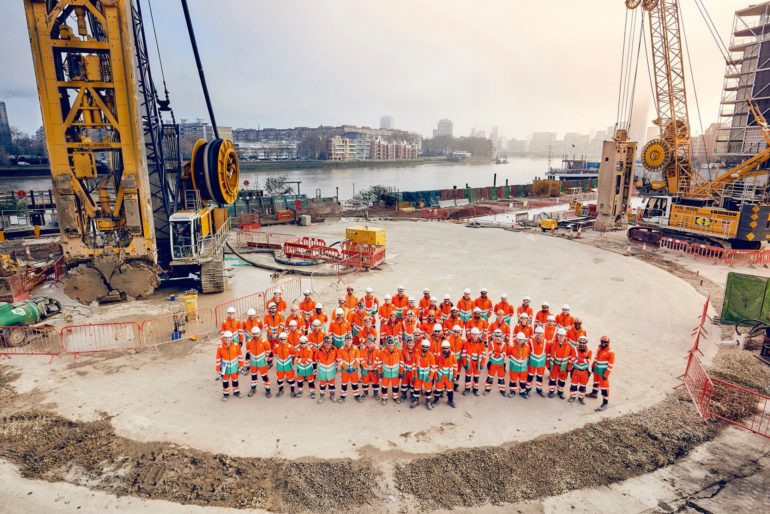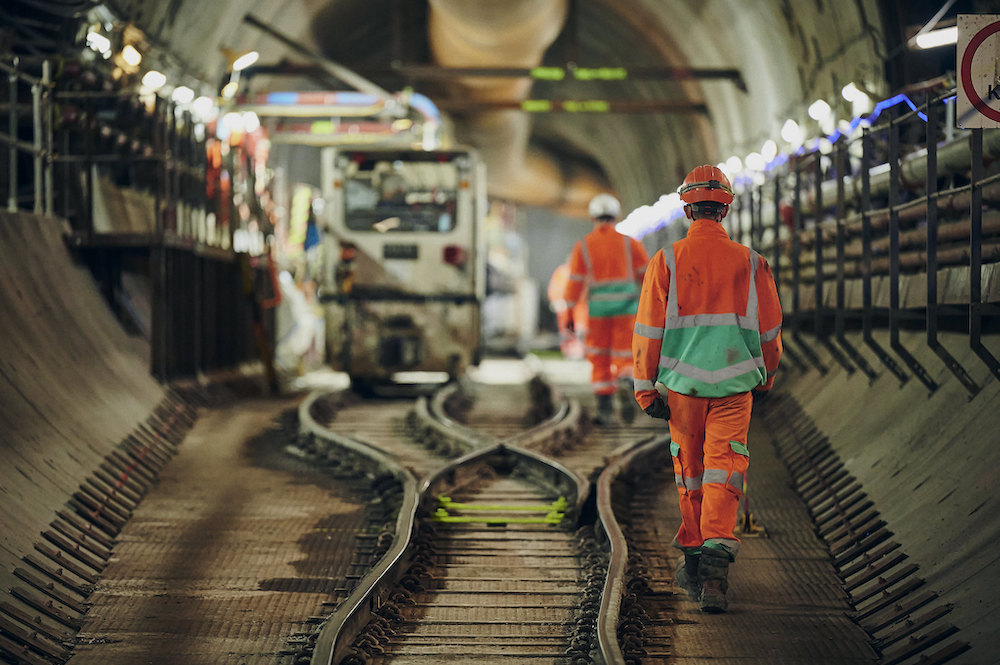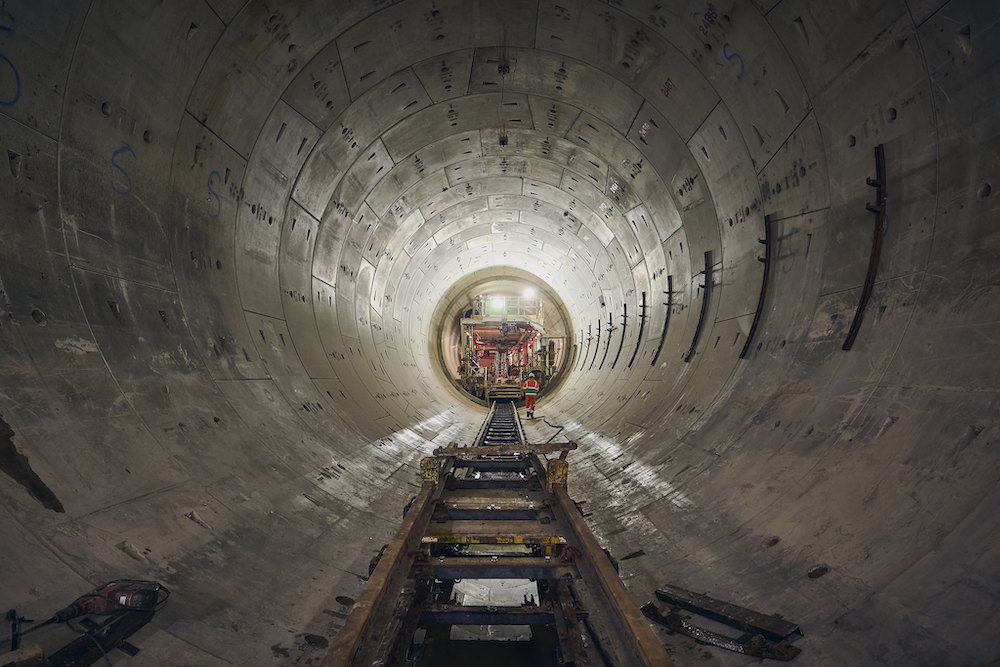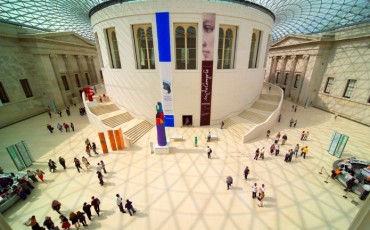London’s five billion pound Super Sewer is now fully connected and promises a cleaner, healthier River Thames. The 150-year-old sewer network has struggled to cope with the twin challenges of an increase in the population it serves in the capital (from four million people when it was built to over nine million today) together with climate change. With rainfall overwhelming the system, it sometimes discharges into the Thames. With the Super Sewer fully connected, 95% of those spills are stopped.
 Tideway workers have begun work on digging a hole with a 30m diameter on the banks of the River Thames. Photo Credit: © Thames Tideway Tunnel.
Tideway workers have begun work on digging a hole with a 30m diameter on the banks of the River Thames. Photo Credit: © Thames Tideway Tunnel.
Thames Super Sewer
Construction began in 2016, and the first sewage flowed into the tunnel in September 2024. Twenty-one connections were made between the original Victorian sewers and the new 25 km/16 mile Thames Tideway Tunnel, thus forming the ‘London Tideway Tunnel’ (LTT) system. The new tunnel runs from Acton in the west to Abbey Mills in the east, where it joins the existing 6.9 km/4.3 mile-long Lee Tunnel which connects to Beckton Sewage Treatment Works. It has been designed to last for at least 120 years and almost 25,000 people worked on the Tideway project.
The main tunnel has an internal diameter of 7.2m/24 ft and runs at a depth of between 30m/98 ft at the western end and 70 metres/230 feet in the east. It will drain thirty-four of the most polluting combined sewer overflows. The sewage flows under gravity as it did in the days of Sir Joseph Bazalgette, who many regard as the founder of London’s sewage system, and is only pumped up and out at Beckton Sewage Treatment works.
Bazalgette Tunnel Limited (BTL), known as ‘The Tideway’, is the licensed Infrastructure Provider set up to finance, build, maintain and operate the Thames Tideway Tunnel. Four giant Tunnel Boring Machines (TBMs) were used to excavate the main ‘Super Sewer’ plus two for smaller connection tunnels (one in Wandsworth and one in Greenwich). Each TBM is named after an inspirational woman with a connection to the local area. For example, TBM Selina is named after Dr Selina Fox, who founded Bermondsey Medical Mission in 1904.
More than twenty one deep shafts – some as wide as the dome of St Paul’s Cathedral – were built across London to divert sewage flows and to lower tunnelling machines into the ground. Over 3.48 million tonnes of spoil was excavated and carried away during tunnelling. Construction material was transported on barges instead of lorries on roads, thereby reducing the number of HGVs needed by 344,000 and avoiding 24,400 tonnes of CO2.
 25km Super Sewer being built under the River Thames. Photo Credit: © Tideway London.
25km Super Sewer being built under the River Thames. Photo Credit: © Tideway London.
When the Tideway project is finished, sections of the Thames Path currently closed to the public will open. Some of the two dozen construction sites will be landscaped and converted into 1.2 ha/3 acres of new public space with thought-provoking works of public art.
Nearly forty artists are working on fifty separate projects.
Putney: Bronze Oars by Claire Barclay were made by casting wooden oars from the handrails on the new foreshore balustrade.
King George’s Park, Wandsworth: In Yemi Awosile’s Domestic Motif bronze elements attached to a concrete kiosk reflect the fact that the artist William Morris had a factory nearby and dyed fabrics in River Wandle. Twenty-one semi-mature and mature trees and shrubs have been planted across the site and a new swale (a sustainable drainage solution) integrated into the grass area to capture and hold rainwater. Thirty trees were planted before construction works began.
Chelsea Embankment’s foreshore will be floodable at times of high tide.
Albert Embankment: Richard Wentworth CBE’s three bronze-cast sculptural seats are in the form of toilets!
Victoria Embankment: Wentworth has also cast a stack of bronze sandbags from hessian bags to act as informal seating to enable people to sit and look out across the river, creating an opportunity for gathering.
Thames Wunderkammer is a cabinet of curiosities. In Mudlarking objects from past and present are juxtaposed to make new meanings.
Blackfriars Bridge Foreshore: Hoarding artwork has been created by Joy Gerrard with students from City of London School, and commissioned by Tideway in 2016.
King Edward Memorial Park (near Rotherhithe Tunnel): An area will be floodable at high tides. A hoarding project called Park Park presents a striking visual collection of rules for five short games that park users of all ages and abilities can enjoy in the Memorial Park and surrounding areas. The games were developed through a collaboration between the local community and the Whitechapel-based artists Matheson Marcault (Holly Gramazio and Sophie Sampson). Games can be played solo or in small groups in different ways for different lengths of time without the need for any special equipment.
Dorothea Smartt was commissioned to write poems for the ventilation columns at nine of the Thames Tideway Tunnel sites. These columns are all accessible for the public to walk close to. All of Smartt’s poems are thematically linked to London’s Lost Rivers – London’s natural drainage system, used as the basis of Sir Joseph Bazalgette’s original sewer network. Twelve of fifty tributaries which flow into the Thames are along the route of the Thames
 Workmen building a 25km Super Sewer under the River Thames. Photo Credit: © Tideway London.
Workmen building a 25km Super Sewer under the River Thames. Photo Credit: © Tideway London.
Thames Tideway Tunnel
A new tunnel has opened under the River Thames. This 1.4 km (0.87 mile) twin-bore tunnel runs between Silvertown on the north side of river and Blackwall in Greenwich and will be designated as the A1026. This tunnel will make peak time journeys faster, enable new cross-river public transport and provide an alternative when the Blackwall Tunnel is closed.
The Silvertown Tunnel was designed, built, financed and is maintained by Riverlinx. The 11.87 metre diameter earth pressure balance Tunnel Boring Machine (TBM) used was supplied by Herrenknecht and named Jill after Jill Viner who, in 1974, was the first female bus driver in London. Herrenknecht, who construct the largest TBMs in the world, provided them for Crossrail, now the Elizabeth line, and for the Gotthard Base Tunnel, the world’s longest and deepest railway tunnel, and for the Brenner Base Railway Tunnel. Both go through the Alps and each machine costs over £10 million and takes up to a year to build.
The Silvertown Tunnel includes dedicated lanes for heavy goods vehicles and buses. Along with an existing bus route through the Blackwall Tunnel, there is room for twenty-one buses an hour during peak times. It is planned that all bus routes will be zero emission. While there is no pedestrian or cycle access, a shuttle bus will operate for cyclists.
All Public Service Vehicles with nine or more passengers and registered in the UK will be allowed to drive through the Blackwall and Silvertown tunnels free of charge. Foreign registered coaches will need to go onto the TfL website and register the vehicle before they use either tunnel. Otherwise, they will have to pay a fine. Your London Blue Badge Guide can do this to ensure a stress-free visit to enjoy these sites.

For more information on the Supersewer see www.tideway.london
For more information on the Tideway tunnel visit tfl.gov.uk/silvertown-blackwall
For further information on tunnel charges, go to: tfl.gov.uk/tunnel-charges
A foreign coach can be registered for the tunnel by going to tfl.gov.uk/modes/driving/







Leave a Reply